The adorably fluffy Rocky Mountain Goat kid born on May 4 has a name! Meet Blanca, named after Blanca Peak – one of Colorado’s tallest mountains. Blanca is growing in leaps and bounds! The young female goat is incredibly independent and energetic. Wait until you see her version of zoomies! She now weighs nearly 30 pounds, has met the full five-member herd of Rocky Mountain goats at CMZoo, and is even learning to take food from keepers.
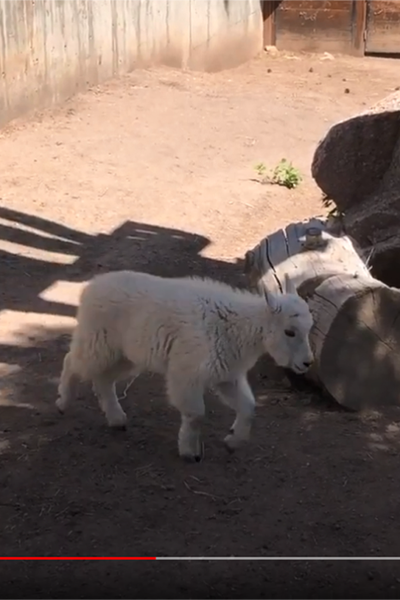

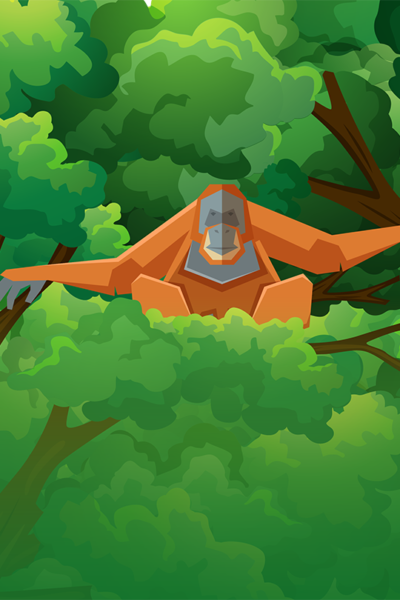

If you’ve ever wanted to save the rainforests from the comfort of your smartphone, now’s your chance. With a brand-new free global mobile app, everyone has the power to advocate with their shopping choices, and to make large companies listen to their demands for sustainably produced palm oil.

Cheyenne Mountain Zoo (CMZoo), under the direction of the World Association of Zoos and Aquariums (WAZA), is launching a mobile app, called PalmOil Scan. The free smartphone app will empower consumers to make informed, environmentally-friendly shopping decisions, just by scanning a barcode. PalmOil Scan is available on the Apple App Store and Google Play in the U.S. and Canada now.
“With this app, consumers can easily make informed choices that benefit wild animals and their habitats,” said Tracey Gazibara, executive vice president at CMZoo and co-chair of the WAZA Palm Oil Subcommittee. “If worldwide consumers show preference for companies that source only sustainable palm oil, we can create a demand that other companies can’t ignore. When more companies realize their potential customers will not stand for the use of unsustainable palm oil, we can prevent more deforestation and help endangered animals recover in the wild.”
Palm oil is an edible oil that can be found in about half of the products consumers purchase. It is used in candy, soaps, cosmetics, pet food, and even toilet paper. Because of high demand, unsustainable palm oil production has resulted in deforestation across Southeast Asia, and other tropical areas, which means critically endangered species like orangutans, tigers, and elephants are losing their homes.
However, when produced sustainably, palm oil is the most productive edible oil available. Oil palms – the trees that palm oil comes from – produce four to ten times more oil than alternatives like soy, olive, canola and coconut. Switching to these alternatives would cause even more deforestation in tropical areas, which is why consumers must demand sustainable palm oil.
Conscientious consumers can scan the barcodes on thousands of products in the app’s extensive database (which is being updated and expanded constantly) to see if they are produced by a company that has committed to sourcing sustainable palm oil. The new app also has a search feature, so if consumers scan a product that isn’t orangutan-friendly, they can easily choose an alternative that is.
Companies that have previously relied on their customers’ lack of knowledge about unsustainable palm oil and its impact on orangutans, tigers, rhinos, and elephants will soon recognize their competitors have the edge on them.
“Companies that continue to use unsustainable palm oil in their products need to see that consumers have the tools and knowledge to find out whether they value the habitats that so many endangered species depend on,” said Gazibara. “Sustainable palm oil production is possible, and it is time for us all to hold companies to a higher standard.”
CMZoo has been a leader in sustainable palm oil advocacy for more than a decade. The Zoo launched a similar mobile app for consumers in the U.S. and Canada in 2014. More than 160,000 verified users have educated themselves by using CMZoo’s app. Its design, database and user experience served as the foundation for the design of PalmOil Scan, which has the potential to reach millions more people around the world.
With the launch of PalmOil Scan, CMZoo has discontinued its former app. Depending on individual smartphone settings, users who previously used the CMZoo palm oil app may have automatically downloaded PalmOil Scan, or they may need to delete the old app and download PalmOil Scan manually. It is available now in the U.S. and Canada, and will be available in additional countries later this year.
To learn more about sustainable palm oil, and how the power of consumer choice can save critically endangered animals in Southeast Asia, visit cmzoo.org/palmoil.
Download the PalmOil Scan App
About Cheyenne Mountain Zoo
Cheyenne Mountain Zoological Society was founded in 1926. Today, Cheyenne Mountain Zoo, America’s mountain Zoo, offers comprehensive education programs, exciting conservation efforts and truly fantastic animal experiences. In 2022, Cheyenne Mountain Zoo was voted #3 Best Zoo in North America and CMZoo’s Rocky Mountain Wild was named #2 Best Zoo Exhibit in North America by USA TODAY 10Best Readers’ Choice Awards. It is Cheyenne Mountain Zoo’s goal to help guests fall in love with animals and nature, and take action to protect them. Since 2008, CMZoo’s Quarters for Conservation program has raised $4 million dedicated to frontline conservation efforts around the world. Of the 239 zoos and aquariums accredited by the Association of Zoos and Aquariums (AZA), Cheyenne Mountain Zoo is one of just a few operating without tax support. Cheyenne Mountain Zoo depends on admissions, membership dues, special event attendance and donations for funding.
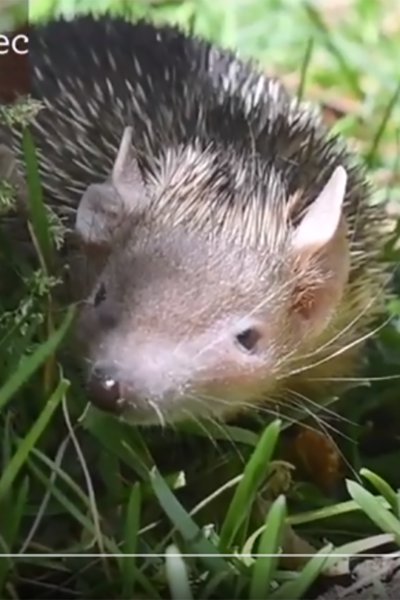

See a few of the new faces at The Loft, The Treehouse and My Big Backyard! From Bubba, our giant African bullfrog, to Nigel, our lesser Madagascar tenrec, Raider the African grey parrot and Ms. Frizzle, our curlyhair tarantula, there are lots of new animal ambassadors to visit on your next trip to CMZoo!
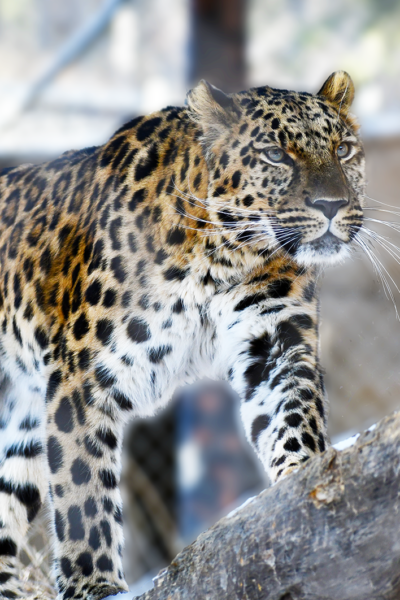

If you’ve visited Asian Highlands at CMZoo lately, you’ve probably noticed a lot of activity around the south leopard habitat. Our keepers, grounds and maintenance crews, and Zoo architect, have been working together to upgrade the leopards’ home, thanks to generous support from a friend of the Zoo.

The cross-departmental CMZoo design team brought different kinds of expertise to the table, each presenting goals and offering solutions to each other’s challenges. The first thing guests will likely notice is how much more of the exhibit they can see. The glass is gone, which means our guests can see the leopards better without a glare, and the huge log-and-steel crossbeam required for the glass-front structure could also be removed. Without that necessary structure, guests will have a much better view of a lounging leopard high in the trees. The leopards’ new perching is closer to the mesh, too, so the cats have a great view overlooking the Zoo. With as few barriers as is safely possible, guests can feel closer to them, which fosters the connections we believe inspire people to support conservation.
“Our goal was to make their home more enriching for the leopards, and more immersive for our guests,” said Basia Dann, Asian Highlands keeper. “They have tons of new perching, an upgraded waterfall, and mesh at the viewing area, instead of glass. So far, guests seem super excited about the glass being gone, and leopards are taking advantage of new opportunities in that habitat.”
Three leopards will use the habitat: Bhutan, a 13-year-old male snow leopard; Anya, an 8-year-old female Amur leopard; and Anadyr, a 6-year-old male Amur leopard. The Amur leopards will sometimes share the space together, and sometimes they’ll explore it alone. When they’re not in the newly remodeled leopard exhibit, they’re exploring other yards, including the guest-facing north leopard yard, just above Australia Walkabout.
Bhutan prefers the solitary life, so he’ll enjoy the new digs by himself. Based on Bhutan’s reaction to his first time in the new setup, he approves.
“Bhutan likes to lay in flatter, cooler spots, so we added some shady soil patches for him by the waterfall,” said Dann. “The first time he came into the exhibit, he spotted one of those patches and immediately went to lie down in it. It’s rewarding to see that our team’s hard work combined with our intimate knowledge of these cats is going to benefit them on a daily basis.”
Most CMZoo visitors are aware of the enrichment activities and training sessions keepers provide to keep our animals mentally and physically fulfilled. But, did you know the habitats themselves are designed to enrich our animals, and to encourage their natural behaviors?
For example, Rocky Mountain goats need vertical opportunities to climb, so their habitat reflects that. Hippos need a combination of water at various depths, and flat land to graze. Orangutans need objects to swing between. Leopards are expert tree climbers, so guests will notice ten new tree perches for them to navigate. They also like to rest up high in the trees, because it gives them a better vantage point. They’re often seen sleeping on their tummies with legs on either side of a large branch, and they have many opportunities for that in their new habitat.

“Our horticulture and grounds teams made the new perching adjustable, which is amazing,” said Dann. “If we find that our perching is too steep, or not steep enough, we can adjust a few bolts and see if the cats prefer things at a different angle. It means we’re not ‘stuck’ with the design, if we find our leopards aren’t engaging with it.”
The team also wanted to upgrade the habitat’s water feature. A previously unused waterfall has been revamped to help keep the leopards cool and provide an immersive, natural sound for guests.
“We want our guests to feel like they’re in the Far East or near a snowmelt stream in the Himalayas, where these big cats roam,” said Dann. “We thought we could do that with the waterfall, but we knew our leopards don’t like to be splashed. That was one of many examples of our teams coming together to find a solution that met all of our needs. Our keepers worked closely with our architect, horticulture, grounds and maintenance teams to get the flow of waterfall just perfect.”
The team also added some big rocks to the center of the pond, and set a low water level, so the leopards have cool rocks to nap on and they can wade into the shallow pond, if they choose to.
All three leopards have explored the new space, and Asian Highland keepers have been happy with their engagement.
“As keepers, we love the relationships we get to build with the animals, but we don’t want their lives to revolve around us,” said Dann. “We work to give them the comfort they seek from a habitat, but also problems to solve as independent beings. I love that we can provide these environments that give them more choices in their daily lives.”
There are a few final touches in the works, including a permanent waist-high fence to replace the temporary barrier that keeps guests at safe distance from the big cats’ mesh fencing. Guests can visit the leopards in Asian Highlands now.
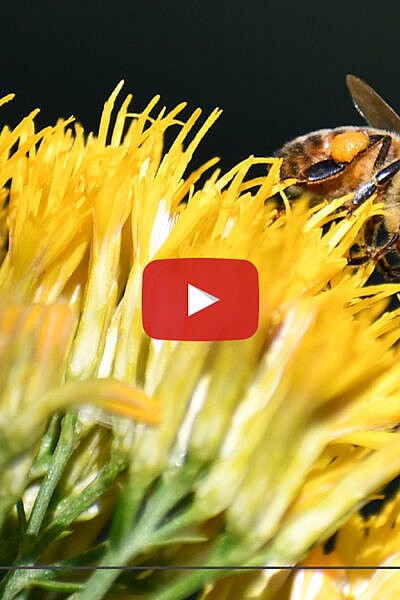

Have you noticed the colorful boxes on top of Grizzly Grill? Those are our new bees’ homes! We welcomed three honeybee colonies earlier this month, and they’re hard at work building their hives. Soon, guests will be able to visit an observation colony in The Treehouse in My Big Backyard. Until then, get up-close to our buzzing busy bees in this video, and perhaps learn a few fun facts about our flying friends.
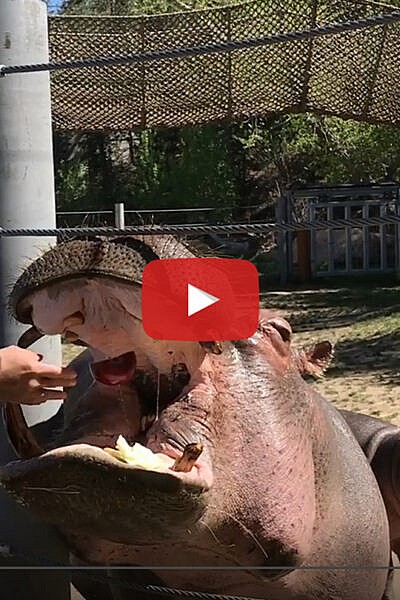

Our 10-month-old Nile hippo calf continues to grow and explore alongside his mom, Zambezi. Join Water’s Edge: Africa lead keeper, Philip, for an update on Omo and another milestone we expect Omo to reach soon: the 500-pound mark! We’ll be hosting a fun guessing game for a Zoo prize on our Facebook and Instagram accounts, so keep an eye out for that. In the meantime, enjoy this yard and poolside check-in with our hippo mom-and-son duo.
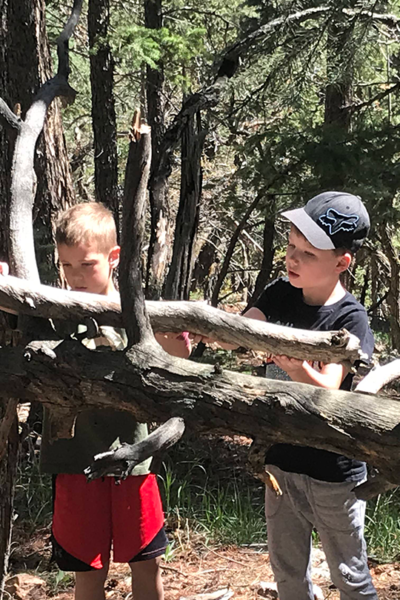

Spending time in nature can help reduce stress and trigger happiness! Cheyenne Mountain Zoo is offering small-group programs that foster connections with nature, the outdoors and each other. Through hands-on interactive experiences, classes will engage the whole person – physically, mentally and emotionally – and build a stronger connection with our natural world.
Outdoor School classes may occur on Zoo grounds or off-site in other nature-based environments. These classes focus less on animals at the Zoo and more on the powerful impact nature has on us as humans. When we care more about wild places, we take better care of them and the creatures that live there. This summer, Cheyenne Mountain Zoo is offering brand-new opportunities to connect with nature:

Nature Hikes: We’ll search for signs of wildlife, like tracks and scat, or explore with our senses on high-alert in a forest at night. After participating in a nature hike workshop, you will see that we share this amazing Colorado home with so many species (some more obvious than others!).
Nature Photography: Photography is a great way to hold onto memories, share stories, and gain knowledge. Photos can allow us to experience nature up-close without a time limit, so we can focus on the details better than our eyes can. Imagine getting closer to monarch eggs or a hummingbird without disturbing them. Through a lens, you can gain an even greater understanding and appreciation for nature.

Nature Play and Exploration: Sometimes the best way to connect with nature is without an agenda, with opportunities to explore, observe, and engage the senses. Though activities are built into these programs, they are guided by participants’ interests and seamlessly flow into their own experiences. We’ll look for specific colors found around us, identify birds, build forts, or climb rocks. These explorations are sure to ignite your inner “wild child.”
These classes and more can be found at cmzoo.org/outdoorschool. Stay tuned to that page for upcoming programs and opportunities for every season throughout the year. Space is limited in each class, so register soon!
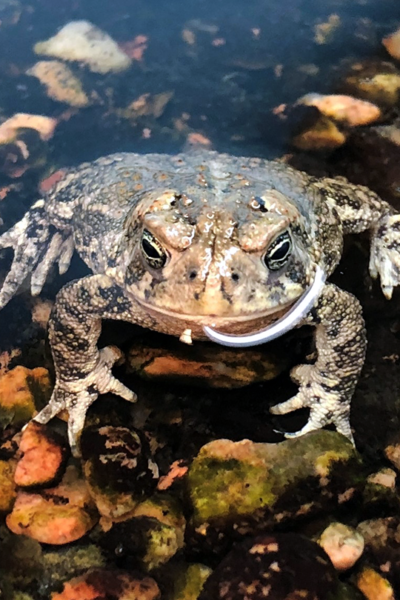

The soft serenade of Wyoming toad mating calls will soon echo through the hallways of the Cheyenne Mountain Zoo conservation center, as Field Conservation Coordinator Jeff Baughman welcomes ten breeding pairs of critically endangered amphibians back from 38 days of hibernation.

“It’s a busy time of year for us,” said Baughman, who has been intimately involved in Wyoming toad recovery at CMZoo since 2008. “The next several weeks are really crucial as we help bring this species back from the brink of extinction. Our adult toads are waking up from hibernation and moving into their breeding suites. Soon, we’ll have our hands full, welcoming thousands of their babies into our care.”
It may sound dramatic, but we believe it is. Wyoming toads are listed as “EW” or “Extinct in the Wild,” on the International Union for the Conservation of Nature (IUCN) Red List of Threatened Species.
Why give a hop? Toads are worth saving. They play a vital role at the center of the prairie environment, as the best bug control available and as sustenance for migrating birds and native mammals in search of food. If the toads don’t survive, the whole ecosystem suffers. They’re also what’s known as an indicator species, meaning they indicate the overall health of their ecosystem – and it’s in desperate need of attention.
Amphibians worldwide are facing mass extinction due to a pandemic known as the Chytrid fungus. Chytrid fungus causes a skin infection that hinders amphibians’ ability to breathe and absorb water. This often leads to organ failure and death. But, thanks to zoos like CMZoo, these hoppers stand a chance.
Over its 26-year commitment to the cause, CMZoo’s conservation team has released more than 41,629 tadpoles and nearly 1,444 toads into the wild. Next week, 66 more one-year-old toads will take their first hops into the wild to join them in the Laramie Basin of Wyoming.
Although the releases happen each June, the team works year-round to prepare for the toads’ and tadpoles’ hopeful sendoff. The yearly process begins by simulating hibernation for the toads. They’re placed in moss-lined containers inside a hibernaculum, which reduces their temperature slowly over a few days to 38 degrees Fahrenheit. The toads, very much alive, stay at that temperature for 35 days, receiving periodic checks from the conservation team who mist and monitor the sleeping beauties.
Over the last few days of their low-temp slumber party, the hibernaculum’s temperature is slowly raised back to around 70 degrees Fahrenheit, and they start to wake up. The cycle triggers their instinct to breed, as they would in the wild after winter, and that’s when the magic happens.
“We bring them out of the hibernaculum and place genetically desirable breeding pairs into tanks,” said Baughman. “We also play audio tracks from the Laramie Basin, which include Wyoming toad breeding calls, so the environment is just right. It only takes about a week for fertilized eggs to develop into tadpoles.”
The team will release thousands of those tadpoles into ponds and streams in Wyoming at the end of June. Some of the tadpoles hatched this year will stay at the Zoo, under the care of the conservation team, to grow into yearling toads before being released the following summer. The tadpoles held back get a yearlong head start at the Zoo, hence the term ‘headstart toads.’ New this year, others will be held back for two years to see if wild reproduction increases with more sexually mature toads being released. Clean Chytrid-free water, climate controls and plenty of yummy meals of crickets and cockroaches give them all a better chance at surviving in the wild. Not to mention, they won’t be on the menu themselves. Most importantly, it means there are more toads ready to breed in the wild because they will have survived and reached reproductive maturity at two years old.

When they’re about eight months old, each toad is microchipped, so when the team goes back to the release location, they can track survivorship or prevalence of the Chytrid fungus. The microchips also help the team identify and monitor individuals during their stay at CMZoo.
Amphibian allies don’t need a hibernaculum or a fresh supply of crickets to help these little guys. Disinfecting outdoor recreation gear used in and near water can stop the spread of the deadly Chytrid fungus. Leaving your fishing or kayaking gear in a hot car or the sun to dry it out for 3 hours, will kill the fungus and prevent water enthusiasts from accidentally transferring it to another body of water.
“Recovering a species definitely takes time,” said Baughman. “But we’ve seen some promising signs that the toads are starting to bounce back – or hop back – in the wild. During field surveys, we’ve seen wild egg strands, which means toads or tadpoles that have been released, or the offspring of released toads, are starting to do the work for us. As a conservationist, there’s nothing you want more than to be out of work.”
This year, Baughman and his team are taking CMZoo followers on a wild real-time adventure, following a group of tadpoles throughout their year of development in the CMZoo conservation center. We’ll share the successes and the struggles these tiny creatures face, even in the safety of their nursery under the care of our team.
“We have a pretty good record of raising tadpoles to adulthood, but they really struggle in the wild,” said Baughman. “In the wild, only about four of every thousand tadpoles makes it to maturity, and that’s on a good year. On a bad year, only about two survive to breeding age, on average.”
Starting in early June, tune into CMZoo’s social channels, on Facebook, Instagram and YouTube, to get closer than ever to ten little tadpoles. Watch in awe as eggs turn into tadpoles. Be mesmerized by metamorphosis, as they grow legs and absorb their tails, earning the title of toadlet. Root for them as they learn to hunt and grow into dime-sized defenders of their species. Then, follow along as they go through the year-long preparation for their eventual wild release in June 2023. We’ll keep you posted.


Migrating birds and pollinators are moving through Colorado, and they’re hungry! As you plan your 2022 summer garden, consider these plants to brighten your backyard and feed our famished flying friends. CMZoo’s Annual Plant Sale, in the Cheyenne Mountain Zoo parking lot May 20-22, 2022, is a great place to stock up.

“Pollinators are extremely important members of our ecosystem, and they’re counting on us to help fuel their impressive migrations,” said Denny Patton, senior horticulturist at Cheyenne Mountain Zoo. “Early blooming perennial plants – which grow back every year – make beautiful additions to your garden when most other plants aren’t blooming yet, and they’re like an oasis in a desert for pollinators in search of food.”
Cheyenne Mountain Zoo’s Annual Plant Sale is a great place to peruse plants. This year, the Zoo’s horticulture fundraising event will be in the Zoo parking lot Friday, May 20, Saturday, May 21 and Sunday, May 22 from 8 a.m. to 5 p.m. There’s no need to make a reservation, and Zoo admission is not required. Plants will be available on a first-come first-served basis, so don’t be late!
This year’s Plant Sale is in-person only. There will be no online shopping or shipping options available. Come out to the Zoo and chat with our expert horticulturists about which plants work best in your garden, and know you’re supporting the ongoing beautification of the Zoo with your purchases.

“Our greenhouse is absolutely popping with plants that will be ready to go into the ground at the end of May,” said Patton. “We have perennials, grasses, shrubs and vines available, including some of my favorite pollinators, like butterfly bushes and catmint. We are also offering lavender, and coral bells, which are beautiful, dark purple evergreen plants with chunky leaves and tall stalks that have tiny flowers on them.”
Here are four pollinator favorites to consider adding to your backyard this year, and you can pick them up at this year’s Plant Sale.
Columbines, Colorado’s state flower, are wildflowers that typically bloom in June, and they have two layers of petals! The uniquely shaped flower’s name comes from the Latin word for ‘dove,’ because the interior white petals can look like five doves clustered together. They come in a variety of colors from red to dark purple, but the light blue Columbine is the color most Coloradans recognize.
Butterfly bushes are unruly shaped perennial shrubs that produce long clusters of tiny, sweet smelling flowers that grow in a cone shape along branches with long leaves. They’re usually purple, magenta, pink or white, and typically grow to be about five feet tall. As if their name wasn’t a hint, these flowers are big-time attractors of butterflies whose flowers usually start to bloom in June.

Husker red foxglove beard tongue is another drought-resistant perennial pollinator plant that does well in Colorado’s sandy soil. These plants bloom mid-spring to early summer, with bright-and-ruby red flowers stems and petite white flowers supported by burgundy-colored foliage. They can grow about 30 inches tall and 18 inches wide, and love full-to-partial sun.
Echinacea tennesseensis, or the Echinacea Tennessee purple coneflower, is a drought-tolerant perennial, and a member of the daisy family. Their lightly-scented purple flowers with copper-orange centers bloom at the ends of long stems, typically mid-summer to early fall. After a few seasons of care, they can grow up to four feet high and 36 inches wide.
With a garden of pollinator perennials that bloom throughout the season, you’ll be ready to welcome butterflies, bees, hummingbirds and more to your own personal paradise. Come by the Annual Plant Sale May 20, 21 and 22 from 8 a.m. to 5 p.m. in the Zoo parking lot to check out our flora options, and to speak with our expert horticulturists about which plants could work well in your garden.
There’s no reservation or admission needed to attend the Plant Sale. All proceeds go to support the Zoo’s horticulture team and projects. Get more information at cmzoo.org/plantsale.
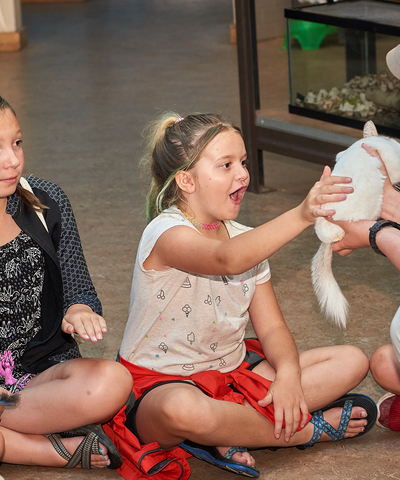

The EdVenture Department at Cheyenne Mountain Zoo has provided the community with wonderful daytime programs for decades. But, did you know they also have a small-group after-hours program for kids, teens and adults, called Starlight Safaris?
Starlight Safaris are a unique way to see the Zoo as your EdVenture guide shares stories, facts and good humor as you explore the Zoo for two hours under a starlit sky.
“I love when I get to share my passion for wildlife and conservation with guests in our evening programs,” said Austin Kennedy, CMZoo Extended Education Supervisor. “It feels more intimate to tour with a group when there are so few people at the Zoo. It’s a pretty special experience to be here at night.”

From the beginning of a Date Night Starlight Safari, just for 21-and-up attendees, guests arrive at the Zoo as the sun goes down, and the howls from the Mexican wolf pack welcome them in to grab an adult beverage of their choice. The groups visit a handful of indoor exhibits throughout the 2-hour tour, including Water’s Edge: Africa, The Loft and of course, feeding the giraffe herd in their barn.
Date Night Starlight Safaris are scheduled from Sun., May 1 to Fri., Aug. 19 and registration is open now at https://www.cmzoo.org/events-programs/schools-groups/evening-tours/date-night-starlight-safari-adults-only-21/. Feel free to join us as a party of one or sign up with your 21-and-up aged friends, work colleagues or partners.
Attendees can also organize their own event on any other available evening, as long as there are six or more participants in a group. Groups can book a Custom Starlight Safari that will include all of the above (adult beverages are only included in the 21-and-up Date Night Starlight Safaris), as well as the opportunity to roast s’mores together (weather dependent). These customized experiences are perfect for birthday celebrations, scout troops, families, team building, friend groups and anyone else you want to share this unique experience with. Start planning your custom event at cmzoo.org/starlight.
Want to give the kids their own night out? Drop them off for one of our prescheduled Kids Only or Teens Only Starlight Safaris! Like the Custom Starlight Safaris, kids will have a chance to roast s’mores during the program (weather dependent).

Teens-Only Starlight Safaris are scheduled for 6:30 to 8:30 p.m. on Fri., May 20 and Sun., May 29. Register here: https://www.cmzoo.org/events-programs/camps-classes/teen-programs/teen-only-starlight-safari-may-20-29/.
Kids-Only Starlight Safaris are scheduled for 6:30 to 8:30 p.m. on Sat., June 11, Fri., June 24 and Sat., July 16. Register here: https://www.cmzoo.org/events-programs/schools-groups/evening-tours/kids-only-starlight-safari-tour-june-11/.
We hope to see you at one of our Starlight Safaris, which are available year-round, soon!